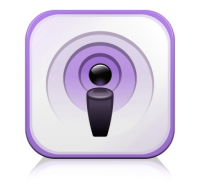 During the twelve hour drive from Michigan to North Carolina and back over the holidays, I listened to a lot of podcasts. I admit it: I’m a podcast addict. Any time I have to drive for an hour or longer, I listen to a podcast–This American Life, The Moth, Ted Talks Radio Hour, Radio Lab, Snap Judgment… All that listening and driving got me thinking about using podcasts in the classroom and why it’s a relevant medium.
During the twelve hour drive from Michigan to North Carolina and back over the holidays, I listened to a lot of podcasts. I admit it: I’m a podcast addict. Any time I have to drive for an hour or longer, I listen to a podcast–This American Life, The Moth, Ted Talks Radio Hour, Radio Lab, Snap Judgment… All that listening and driving got me thinking about using podcasts in the classroom and why it’s a relevant medium.
Connection to Standards
The Common Core Standards prioritize speaking and listening skills in a fairly rigorous way. ELA teachers have always valued speaking and listening skills and given students the opportunity to develop them in their classrooms. But with the adoption of the Standards, these skills are now clearly defined and progress in complexity from year to year, meaning teachers and departments have to think about how they’ll address speaking and listening in a comprehensive way. Often when we think of the speaking and listening standards, our minds immediately go to discussion–how to get students to engage in rich and complex discourse. But in this post I want to focus on the podcast medium as a fairly exciting way for teachers and students to explore close listening together. Listening to podcasts as nonfiction texts (a great way to infuse your curriculum with more nonfiction!) directly addresses these two standards:
Speaking & Listening Standard 2: Integrate and evaluate information presented in diverse media and formats, including visually, quantitatively, and orally.Speaking & Listening Standard 3: Evaluate a speaker’s point of view, reasoning, and use of evidence and rhetoric.
Why Is Podcasting an Important Medium?
 I remember talking to a colleague a few years ago who proclaimed that podcasting was not new media. She said it was just recorded radio and that podcasting was over. But podcasting is so not over and it’s a lot more than recorded radio. Sometimes podcasts never appear first on the radio at all. So why is this an important and popular media form?
I remember talking to a colleague a few years ago who proclaimed that podcasting was not new media. She said it was just recorded radio and that podcasting was over. But podcasting is so not over and it’s a lot more than recorded radio. Sometimes podcasts never appear first on the radio at all. So why is this an important and popular media form?
- Podcasts are available on demand via our mobile devices, thanks to iTunes and the websites of popular podcasts. So we can listen anytime, anywhere.
- There is a growing library of free, high-quality podcasts on a wide range of subjects.
- They run the gamut of nonfiction genres: storytelling, informational, and argument-focused podcasts ranging in purposes from entertainment to news to self-help (exercise, nutrition, spirituality, emotional health).
- We can multi-task while we listen–drive, make dinner, walk the dog, exercise at the gym.
- As with other digital texts, the general public (students!) can create and publish podcasts–and they are in fairly high numbers.
Start with Serial
 In October, I was over the moon when Serial, a This American Life spin off that follows a single story for twelve episodes came out. From episode one, I was hooked. So rather than talk about strategies for integrating this medium in your classroom (that will be my next post), I’m going to make a pitch for using this new podcast. I would suggest that for high school classes, especially juniors and seniors, Serial is a great place to start. (I’m not alone. A California high school teacher has replaced the study of Hamlet with Serial.) Why? Well, here’s the context for the start of this story…
In October, I was over the moon when Serial, a This American Life spin off that follows a single story for twelve episodes came out. From episode one, I was hooked. So rather than talk about strategies for integrating this medium in your classroom (that will be my next post), I’m going to make a pitch for using this new podcast. I would suggest that for high school classes, especially juniors and seniors, Serial is a great place to start. (I’m not alone. A California high school teacher has replaced the study of Hamlet with Serial.) Why? Well, here’s the context for the start of this story…
It’s Baltimore, 1999. Hae Min Lee, a popular high-school senior, disappears after school one day. Six weeks later detectives arrest her classmate and ex-boyfriend, Adnan Syed, for her murder. He says he’s innocent – though he can’t exactly remember what he was doing on that January afternoon.
Adnan, a popular student with strong ties to the Muslim community, is later found guilty and sentenced to life in prison. He was 18. And as the very first episode of Serial unravels for its listeners, the evidence was contradictory and, in some instances, spotty.
Other compelling reasons to use Serial in the classroom:
 It’s great storytelling and relevant to your students. The cast of characters is almost entirely high school students (or they were at the time of the murder) living through the things your students experience–juggling school and extracurriculars, navigating cultural differences between home life and school life, experiencing young love, making their way through the simmering stew of high school social life. This will seriously engage your students.
It’s great storytelling and relevant to your students. The cast of characters is almost entirely high school students (or they were at the time of the murder) living through the things your students experience–juggling school and extracurriculars, navigating cultural differences between home life and school life, experiencing young love, making their way through the simmering stew of high school social life. This will seriously engage your students.- Serial has changed the face of podcasting. It’s like the True Detective of radio (with a lot less violence). People could not wait for each new episode of Serial to be released on Thursdays and there was no telling which direction the story would turn and if the producers would decide to declare Adnan innocent or guilty. It has been downloaded more than any other podcast–more than 5 million times. And unlike many mainstream podcasts, it was not orignially broadcast on the radio. To read more about Serial’s popularity and possible reasons for it, check out this Salon article.
- It has caused a stir on the internet. People are blogging about it, arguing about it, and commenting non-stop. There have been many articles published as the story has unfolded week to week. The number of Serial-related threads on Reddit alone are a clear indicator of how this podcast has captured people’s imaginations. And there’s a new two-part interview with the star witness whose testimony led to Adnan’s conviction and life sentence.
- The Serial website contains all kinds of really cool visual artifacts related to each episode. Using these in conjunction with the episodes means students can analyze across media–a Common Core dream!
- Serial provides endless ways to study central idea/claim, argument and evidence, theme, bias, character development and text structure.
If you don’t want to commit to all twelve episodes of Serial, consider using only the first episode. That 60 minute audio text alone will make for some very interesting and creative teaching and learning. In my next post, I’ll talk about developing close listening and annotation skills and other ways of using podcasts in the classroom. I’ll also suggest specific episodes from other podcasts you might use.
Do you have any podcasts you love? Please share in the comments section. And if you’re already using podcasts in your classroom, please share your ideas!
Reading Podcast Power: Listening Skills & Curriculum, part 2
 Delia DeCourcy joined Oakland Schools in 2013 after a stint as an independent education consultant in North Carolina where her focus was on ed tech integration and literacy instruction. During that time, she was also a lead writer for the Common Core-aligned ELA writing units. Prior to that, she was a writing instructor at the University of Michigan where she taught first-year, new media, and creative writing and was awarded the Moscow Prize for Excellence in Teaching Composition. In her role as secondary literacy consultant, Delia brings all her writing, curriculum design, administration, and teaching skills to bear, supporting districts in their implementation of the Common Core via onsite workshops and consultations, as well as workshops at Oakland Schools. She is currently spearheading the development of literacy-focused online professional learning modules as well as the building of a virtual portal where Michigan educators can learn and collaborate.
Delia DeCourcy joined Oakland Schools in 2013 after a stint as an independent education consultant in North Carolina where her focus was on ed tech integration and literacy instruction. During that time, she was also a lead writer for the Common Core-aligned ELA writing units. Prior to that, she was a writing instructor at the University of Michigan where she taught first-year, new media, and creative writing and was awarded the Moscow Prize for Excellence in Teaching Composition. In her role as secondary literacy consultant, Delia brings all her writing, curriculum design, administration, and teaching skills to bear, supporting districts in their implementation of the Common Core via onsite workshops and consultations, as well as workshops at Oakland Schools. She is currently spearheading the development of literacy-focused online professional learning modules as well as the building of a virtual portal where Michigan educators can learn and collaborate.
